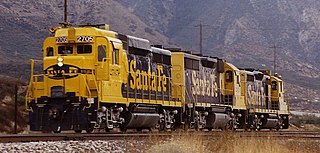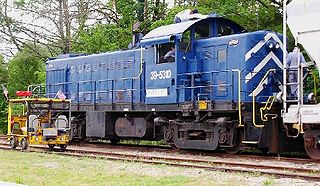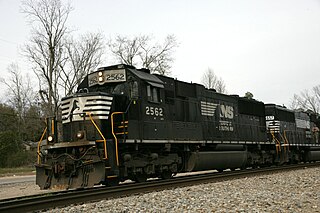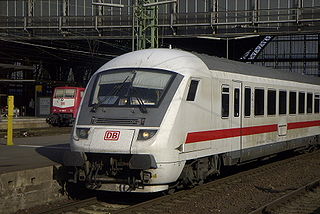
Multiple-unit train control, sometimes abbreviated to multiple-unit or MU, is a method of simultaneously controlling all the traction equipment in a train from a single location—whether it is a multiple unit comprising a number of self-powered passenger cars or a set of locomotives—with only a control signal transmitted to each unit. This contrasts with arrangements where electric motors in different units are connected directly to the power supply switched by a single control mechanism, thus requiring the full traction power to be transmitted through the train.
Rail transport terms are a form of technical terminology applied to railways. Although many terms are uniform across different nations and companies, they are by no means universal, with differences often originating from parallel development of rail transport systems in different parts of the world, and in the national origins of the engineers and managers who built the inaugural rail infrastructure. An example is the term railroad, used in North America, and railway, generally used in English-speaking countries outside North America and by the International Union of Railways. In English-speaking countries outside the United Kingdom, a mixture of US and UK terms may exist.

The EMD GP30 is a 2,250 hp (1,680 kW) four-axle diesel-electric locomotive built by General Motors Electro-Motive Division of La Grange, Illinois between July 1961 and November 1963. A total of 948 units were built for railroads in the United States and Canada, including 40 cabless B units for the Union Pacific Railroad.

A road switcher locomotive is a type of railroad locomotive designed to both haul railcars in mainline service and shunt them in railroad yards. Both type and term are North American in origin, although similar types have been used elsewhere.

The EMD SD70 is a series of diesel-electric locomotives produced by the US company Electro-Motive Diesel. This locomotive family is an extension and improvisation to the EMD SD60 series. Production commenced in late 1992 and since then over 5,700 units have been produced; most of these are the SD70M, SD70MAC, and SD70ACe models. While the majority of the production was ordered for use in North America, various models of the series have been used worldwide. All locomotives of this series are hood units with C-C trucks, except the SD70ACe-P4 and SD70MACH which have a B1-1B wheel configuration, and the SD70ACe-BB, which has a B+B-B+B wheel arrangement.
Early Electro-Motive Corporation switcher locomotives were built with Winton 201-A engines. A total of 175 were built between February 1935 and January 1939. Two main series of locomotives were built, distinguished by engine size and output: the straight-8, 600 hp (450 kW) 'S' series, and the V12, 900 hp (670 kW) 'N' series. Both were offered with either one-piece cast underframes from General Steel Castings of Granite City, Illinois, denoted by 'C' after the power identifier, and fabricated, welded underframes built by EMC themselves, denoted by 'W'. This gave four model series: SC, SW, NC and NW. Further developments of the 900 hp (670 kW) models gave model numbers NC1, NC2, NW1, and NW1A, all of which were practically indistinguishable externally from the others, as well as a pair of unique NW4 models for the Missouri Pacific Railroad and a solitary, twin-engined T transfer locomotive model built for the Illinois Central Railroad.

The EMD SD40-2 is a 3,000-horsepower (2,200 kW) C-C diesel-electric locomotive built by EMD from 1972 to 1989.

The Evolution Series is a line of diesel locomotives built by GE Transportation Systems, initially designed to meet the U.S. EPA's Tier 2 locomotive emissions standards that took effect in 2005. The line is the direct successor to the GE Dash 9 Series. The first pre-production units were built in 2003. Evolution Series locomotives are equipped with either AC or DC traction motors, depending on the customer's preference. All are powered by the GE GEVO engine.

The EMD GP7 is a four-axle (B-B) diesel-electric locomotive built by General Motors Electro-Motive Division and General Motors Diesel between October 1949 and May 1954.

The EMD GP9 is a four-axle diesel-electric locomotive built by General Motors' Electro-Motive Division between 1954 and 1959. The GP9 succeeded the GP7 as the second model of EMD's General Purpose (GP) line, incorporating a new sixteen-cylinder engine which generated 1,750 horsepower (1.30 MW). This locomotive type was offered both with and without control cabs; locomotives built without control cabs were called GP9B locomotives.

The EMD GP38-2 is an American four-axle diesel-electric locomotive built by General Motors, Electro-Motive Division. Part of the EMD Dash 2 line, the GP38-2 was an upgraded version of the earlier GP38. Power is provided by an EMD 645E 16-cylinder engine, which generates 2,000 horsepower.
B-B and Bo-Bo are the Association of American Railroads (AAR) and British classifications of wheel arrangement for railway locomotives with four axles in two individual bogies. They are equivalent to the B′B′ and Bo′Bo′ classifications in the UIC system. The arrangement of two, two-axled, bogies is a common wheel arrangement for modern electric and diesel locomotives.
This article contains a list of terms, jargon, and slang used to varying degrees by railfans and railroad employees in the United States and Canada. Although not exhaustive, many of the entries in this list appear from time to time in specialist, rail-related publications. Inclusion of a term in this list does not necessarily imply its universal adoption by all railfans and railroad employees, and there may be significant regional variation in usage.

The EMD GP16 is a series of rebuilt diesel-electric locomotives, a result of a remanufacturing program initiated by the Seaboard Coast Line Railroad (SCL) in an effort to spare the cost of purchasing new motive power in the late 1970s. This involved the rebuilding of their aging fleet of EMD GP7, GP9 and GP18 road switchers. 155 locomotives were rebuilt by the SCL.

The long hood of a hood unit-style diesel locomotive is, as the name implies, the longer of the two hoods on a locomotive, particularly American-type freight locomotives.

A control car, cab car, control trailer, or driving trailer is a non-powered rail vehicle from which a train can be operated. As dedicated vehicles or regular passenger cars, they have one or two driver compartments with all the controls and gauges required to remotely operate the locomotive, including exterior locomotive equipment such as horns, bells, ploughs, and lights. They also have communications and safety systems such as GSM-R or European Train Control System (ETCS). Control cars enable push-pull operation when located on the end of a train opposite its locomotive by allowing the train to reverse direction at a terminus without moving the locomotive or turning the train around.

The Krauss-Maffei ML 4000 is a road switcher diesel-hydraulic locomotive, built between 1961 and 1969 by German manufacturer Krauss-Maffei in Munich, Germany. It generated 3,540 horsepower (2,640 kW) from two Maybach V16 engines. 37 examples were built for two North American railroads and one South American railroad.

The cab, crew compartment or driver's compartment of a locomotive, or a self-propelled rail vehicle, is the part housing the train driver, fireman or secondman, and the controls necessary for the locomotive or self-propelled rail vehicle's operation.

The South African Railways Class 33-400 of 1968 was a South African and Namibian diesel-electric locomotive.

The Dash 9 Series is a line of diesel locomotives built by GE Transportation. It replaced the Dash 8 Series in the mid-1990s, and was superseded by the Evolution Series in the mid-2000s. Dash 9 series locomotives are some of the most common in the United States.

















